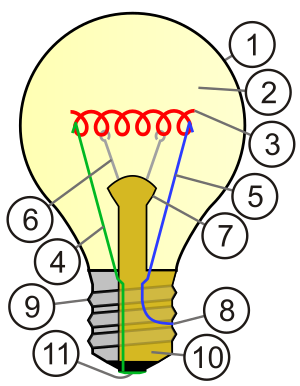
Diagram showing the major parts of a modern incandescent light bulb. Glass bulb Inert gas Tungsten filament Contact wire (goes to foot) Contact wire (goes to base) Support wires Glass mount/support Base contact wire Screw threads Insulation Electrical foot contact (Photo credit: Wikipedia)
Lighting up your life used to be fairly simple. There was a ceiling rose in every room into which you plugged a standard incandescent bulb. You only really had two choices. Firstly, the brightness, so wherever you wanted a lot of light, you would go for a 100 watt bulb. If you wanted more subdued lighting, a 40 watt bulb would do. If you were looking for a halfway house between the two, there was always the 60 watt bulb. The only other choice you had was either a bayonet or a screw fitting.
Unless you lived in a chaotic household, the fitting was always the same so a stash of bulbs of various wattage beneath the sink was enough to keep the lights glowing.
Things have changed. The incandescent bulb is woefully inefficient, so greener bulbs are now in vogue. These come in a myriad of sizes, from the ones that are so tiny you almost need tweezers to get them into place right up to fairly butch bulbs with industrial fittings. Fashion has also changed. The single dangling rose from the ceiling has been replaced with lamps made up of a multiplicity of light sockets.
We have one in our hallway with 12 bulbs. In an idle moment in our local DIY store, I read the outside of the box containing the bulbs. A quick bit of mental arithmetic told me that I would be up on a ladder changing a bulb in that particular fitting every month. We only have a handful of bedrooms and yet, there are 40 or so bulbs in our property.
Who thought this would be a good idea? I can imagine that the lightbulb industry loves it. Buying a bulb used to be like buying a commodity. Buying a bulb now is a bit like buying a water filter for a 1940 Traction Avant. There are only so many places you can get them and there is a hefty price to pay.
All of the packaging of these bulbs screams out how energy-efficient they are, but I can’t help thinking that there is an awful lot more waste. Although each individual bulb is more energy-efficient than an equivalent incandescent bulb, we now have so many more of them, which means we throw many more away. Surely that has an environment impact. Not to mention the packaging and the transport costs.
Maybe we’ll go back to candles.
Related articles
- LED Revolution (dddusmma.wordpress.com)
- Congress tries to turn off lights on bulb mandates (fuelfix.com)
- House again votes to block law requiring energy-efficient light bulbs (upi.com)
- How to Save Energy and Money (insureyes.com)
- L.E.D. There Be Light (science.kqed.org)
- Congress Has At Least One Bright Idea (bluegrassbulletin.com)
- Facts about LED Lighting Bulbs (multisourcetechnologies.org)
- Yeah, Incandescent Light Bulbs Have Pretty Much Been Banned (motherjones.com)
- The Pros And Cons Of LED Lighting (keboto.org)
- Why do your 5 Year Lights Last Only a Few Weeks? (epicahome.com)
Filed under: technology























